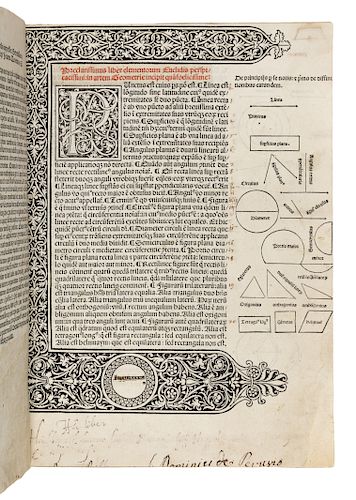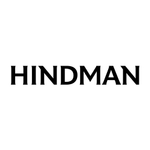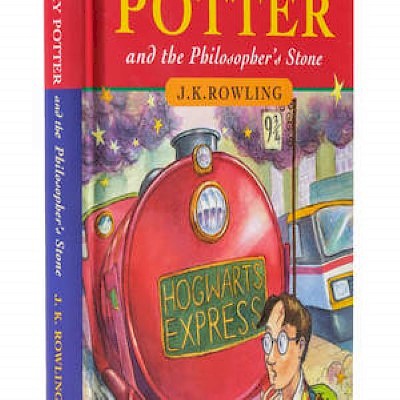EUCLID (fl. ca. 300 B.C.). Elementa geometriae. Translated from the Arabic by Adelard of Bath. Edited by Giovanni Campano. Venice: Erhard Ratdolt, 25
Lot 37
About Seller
Hindman
1338 West Lake Street
Chicago, IL 60607
United States
Recognized as the Midwest's leading fine art auctioneers, Hindman Auctioneers has built a worldwide reputation based on a full service approach to the auction business tailored to meet the individual needs of our clients. Coming from a variety of educational backgrounds, specialists bring years of e...Read more
Categories
Estimate:
$60,000 - $80,000
Absentee vs Live bid
Two ways to bid:
- Leave a max absentee bid and the platform will bid on your behalf up to your maximum bid during the live auction.
- Bid live during the auction and your bids will be submitted real-time to the auctioneer.
Bid Increments
| Price | Bid Increment |
|---|---|
| $0 | $25 |
| $500 | $50 |
| $1,000 | $100 |
| $2,000 | $250 |
| $5,000 | $500 |
| $10,000 | $1,000 |
| $20,000 | $2,500 |
| $50,000 | $5,000 |
| $100,000 | $10,000 |
About Auction
By Hindman
Nov 5, 2019
Set Reminder
2019-11-05 11:00:00
2019-11-05 11:00:00
America/New_York
Bidsquare
Bidsquare : Library of a Midwestern Collector
https://www.bidsquare.com/auctions/hindman-auctions/library-of-a-midwestern-collector-4496
Hindman Bidsquare@hindmanauctions.com
Hindman Bidsquare@hindmanauctions.com
- Lot Description
EUCLID (fl. ca 300 B.C.). Elementa geometriae. Translated from the Arabic by Adelard of Bath. Edited by Giovanni Campano. Venice: Erhard Ratdolt, 25 May 1482.
Super-chancery folio (284 x 206 mm). Collation: a10 b-r8 (a1r blank, a1v printer's dedication to Giovanni Mocenigo, doge of Venice, a2r text, r7v colophon, r8 blank). 137 leaves (of 138, lacking final blank). 45 lines and headline. Variant settings conform to GW main entry. Types 3:91G (text), 7:92G (preface and propositions), 7B:100R (headlines, capitals only), 6:56G (diagram lettering). Heading on a2r red-printed, three-quarter white-vine woodcut border (BMC 2b, Redgrave 3), possibly by Bernhard Maler, 15 ten-line and numerous five-line black-on-white woodcut initials, over 500 marginal woodcut and type-rule diagrams. (Lower and inner margins with old restoration, first quire with lower fore-corners restored, 7 woodcut diagrams shaved, a few wormholes to first few leaves, single small wormhole continuing through quire i, 2 small marginal wormholes in last 2 quires, minor marginal dampstaining at end, bifolia m3.6 and m4.5 misbound.) Modern vellum over pasteboard; morocco folding case. Provenance: Copious marginal notes and geometrical diagrams in a contemporary hand in Books I-V (a few cropped), a few minor textual corrections in the same hand; effaced 16th-century inscription on a2r; Perugia, Dominicans(?) (17th-century inscription on a2r, cropped); sold Christie’s New York, 1998, sale 8920, lot 23. THE "OLDEST MATHEMATICAL TEXTBOOK STILL IN COMMON USE TODAY" (PMM) FIRST EDITION, second state, one of the earliest printed books with geometrical figures. The text is the standard late medieval recension of Campanus of Novara (d. 1296), based principally on the 12th-centry translation from the Arabic by Adelard of Bath. Adelard, one of the most important medieval English translators and natural philosophers, left three Latin versions of the Elements, the first a strict translation of the Arabic version, the second and most popular an abbreviated paraphrase of the first version, and the third a commentary. Campanus' version is a free reworking of earlier Latin translations, mainly Adelard's Version II, with additional proofs that make it "the most adequate Arabic-Latin Euclid of all... With an eye to making the Elements as self-contained as possible, he devoted considerable care to the elucidation and discussion of what he felt to be obscure and debatable points" (DSB). Campanus' text was reprinted at least thirteen times in the 15th and 16th centuries. Ratdolt's edition is one of the most beautifully printed of early scientific books. His method of printing diagrams in the margins to illustrate a mathematical text and his finely printed astronomical books became the models for much subsequent scientific publishing. BMC V, 285 (IB. 20513); Dibner Heralds of Science 100; GW 9428; Essling 282; Grolier/Horblit 27; PMM 25; Redgrave 26; Sander 2605; Stillwell Science 163; Thomas-Stanford 1a; Goff E-113.
For condition inquiries please contact Gretchen Hause at gretchenhause@hindmanauctions.comCondition
- Shipping Info
-
Please refer to https://hindmanauctions.com/shipping-packing
-
- Buyer's Premium



 EUR
EUR CAD
CAD AUD
AUD GBP
GBP MXN
MXN HKD
HKD CNY
CNY MYR
MYR SEK
SEK SGD
SGD CHF
CHF THB
THB














